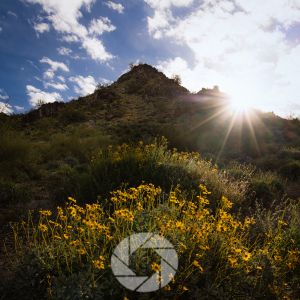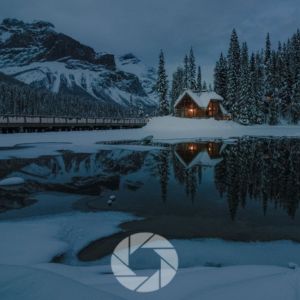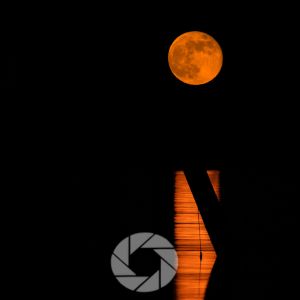
What is focus stacking in landscape photography, and why should it be part of your toolkit?
If you’ve ever stood in awe before a grand scene, crisp rocks at your feet, a shimmering lake in the middle ground, and jagged peaks in the distance, you’ve probably wished for a way to keep everything razor sharp. That’s exactly where focus stacking comes in.
In this post, I’ll walk you through what focus stacking is, when to use it, how to do it, and why it’s a game-changer for anyone looking to elevate their landscape photography.
Whether you’re shooting with a DSLR or a mirrorless setup, this guide will help demystify the process and give you the confidence to start stacking like a pro.
Get Edge to Edge Sharpness with Focus Stacking
What is Focus Stacking?
For many photographers, especially those exploring dramatic depth in landscapes, focus stacking offers a way to go beyond the limitations of a single shot. It’s a technique that gives you full creative control over sharpness from front to back.
Focus stacking is a digital photography technique where multiple images, each focused at different distances, are combined to create a final photo with enhanced depth of field; sharp from foreground to background.
It emerged from macro photography and has become a powerful tool in landscape work to overcome the limitations of traditional focusing methods.
Discover Your Next Journey – These Tours are designed for people who connect with light and landscape.
Why You Should Focus Stack
Landscape scenes often feature elements both near and far; rocks, wildflowers, mountains. While you can stop your aperture down to f/16 to f/22, that introduces diffraction and softens fine details.
Focus stacking lets you shoot at a sharper aperture like f/8–f/11 and combine multiple focused shots to maintain clarity throughout the image from foreground to background.
When You Should Focus Stack
You should consider focus stacking when:
Close Foreground Subject
Foreground subjects are very close such as rocks or flowers just inches away from your lens require more Depth of Field than a single frame can provide, even at small apertures.
One of the most common situations where focus stacking becomes essential is when you’re shooting a composition that includes objects just inches from your lens; think wildflowers, textured rocks, or frost-covered leaves.
Even at f/16 or f/22, a single shot can’t maintain sharpness from that ultra-close foreground all the way to a distant mountain range. Physics simply won’t allow it. That’s when focus stacking shines.
By capturing multiple frames (each focused at different points from front to back) you can ensure every inch of your scene is razor-sharp. This is especially powerful in wide-angle landscape photography, where strong foregrounds pull the viewer into the scene.
Telephoto Images
Using telephoto lenses, which naturally produce shallow depth of field even at narrow apertures. Telephoto lenses naturally compress depth and isolate subjects beautifully, but they also produce very shallow depth of field, even at smaller apertures like f/11.
So if you’re zoomed in to 200mm to photograph a layered ridgeline or a blooming tree in front of distant peaks, you might find that only a narrow slice of the image is in focus. Focus stacking lets you overcome this limitation by blending multiple images with varying focus points.
The result? A stunning image with edge-to-edge sharpness that retains that lovely compressed look only a telephoto lens can give.
Maximizing Image Quality
Pursuing maximum image quality, shooting at the lens’s “sweet spot” without sacrificing depth of field. Landscape photographers often aim to shoot at their lens’s “sweet spot”, usually around f/8 to f/11, where image sharpness, contrast, and overall quality are at their peak.
But here’s the trade-off: at these mid-range apertures, you don’t get as much depth of field. Focus stacking is the elegant solution. Instead of stopping down to f/22 (and introducing softness from diffraction), you can shoot multiple frames at f/8, focus stack them, and get both incredible sharpness and complete depth of field.
It’s an ideal approach when you’re chasing that clean, professional look for large prints or portfolio shots.
Shooting Macros
In macro photography, especially in nature and landscape contexts like frost patterns, mushrooms, or small plants, the depth of field is razor-thin, even at the smallest apertures. Sometimes you’ll get just the tip of a petal or a sliver of a leaf in focus.
Focus stacking solves this problem beautifully. By capturing a series of images while slightly shifting your focus (either manually or using a macro rail), you can stack them together to create one image that’s tack sharp from front to back.
Focus Stacking opens up an entire world of storytelling in miniature, where textures, patterns, and tiny natural elements take center stage.
📸Learn for free!
➡️ FREE Wallpapers and Guides
➡️ DISCOUNTS on future Tours & Tutorials
➡️ TIPS for improving Your photography

I don’t share your Info with anyone. You can unsubscribe at anytime.
Why You Shouldn’t Focus Stack
While focus stacking can be a powerful tool for achieving front-to-back sharpness, it’s not always the right approach and knowing when not to use it is just as important as knowing when you should.
Movement in the Scene Causes Ghosting or Misalignment
Focus stacking relies on multiple exposures taken in rapid succession. That’s great when your scene is still, but not when you’re working with dynamic elements like tall grass blowing in the breeze, waves breaking on a shoreline, or branches rustling in the wind (more on this below).
These shifting elements won’t line up between frames, and when you try to merge them, you’ll end up with ghosting or unnatural blurs in your final image.
Yes, some software can mask this to a degree, but it adds a layer of complexity and often compromises the natural look of the scene. When nature’s in motion, a single well-timed exposure usually gives better results.
It Adds Technical Complexity to Both Shooting and Editing
Focus stacking isn’t something you just turn on and go; it requires deliberate setup, careful focus bracketing, and often tripod stability.
In post-processing, you need software capable of blending those frames accurately; Photoshop, Helicon Focus, or ON1 Photo RAW, for instance. If your gear isn’t aligned just right, or your exposures aren’t clean, the stacking process can turn frustrating fast.
For beginners or even seasoned pros working under time pressure or in the cold, it might not be worth the hassle when a single exposure will do the job just fine.
Sometimes, It’s Simply Not Necessary
Not every scene needs ultra-sharpness from your toes to the horizon. In fact, many compositions benefit from a natural depth of field where the background falls gently out of focus.
If your foreground subject isn’t too close or you’re shooting at a focal length and distance that gives you the coverage you need at, say, f/11, then there’s no real advantage to stacking.
You’re adding complexity for no gain. In those cases, sticking with a single exposure lets you focus on light, timing, and mood, without overcomplicating your process.
Depth of Field Can Be an Artistic Choice
Sharpness isn’t always the goal. Sometimes you want a soft background to isolate your subject, or a blur to lead the viewer’s eye.
In storytelling-focused images, depth of field is a creative decision; just like composition or lighting. Focus stacking removes that nuance by bringing everything into equal clarity, which might work against the narrative you’re trying to build. Trust your instinct.
If selective focus better expresses the emotion of the scene, go with it.
Focus Stacking When its Windy
Windy conditions makes focus stacking a bit more labor intensive. Taking several frames in succession and then blending will result in blurry foliage. The trick is to take a photo of the foliage at a high enough shutter speed to freeze motion. Then, carry on with focus stacking the remainder of the scene.
Do I Need a Tripod for Focus Stacking?
A tripod is strongly recommended. Precise framing and alignment are critical and even minute movements between frames can complicate or degrade the final stack. While modern cameras and software can auto-align images, a tripod ensures consistent framing for the cleanest results.
That being said, I have captured scenes with handheld focus stacking. A wide enough frame plus the stabilization in modern cameras makes that possible. I can envision a future where tripods are a thing of the past, except for longer exposures of a few seconds or greater.
How to Focus Stack: Step-by-Step Process In-Field
Set Up Your Tripod and Compose Your Shot
To get started with focus stacking, a tripod is essential. Stability is important here. Depending on the shot, camera movement between stacked shots will make blending more difficult (or even impossible).
Set up your tripod on solid ground, double-check that it’s level, and carefully compose your scene. I recommend using a remote shutter release or your camera’s self-timer to reduce the risk of shake.
Before moving on, take a moment to evaluate your focus throughout the frame. Look at the scene from foreground to background and mentally note the zones you want to keep sharp; this will guide your focusing strategy in the next steps.
Choose a Sharp Aperture (f/8–f/11)
Aperture plays a crucial role in focus stacking. While you could crank it to f/16 or f/22 to try to get everything in focus, doing so introduces diffraction, which actually reduces sharpness.
Instead, stick with the sweet spot of your lens; usually between f/8 and f/11. This gives you optimal sharpness while still allowing enough depth of field that you don’t need to take dozens of frames.
Focus Manually (or Use Bracketing) From Nearest to Farthest Point
With your shot composed and aperture set, it’s time to begin capturing your focus slices. There are two main methods: manual and automatic.
Manual Focus Stacking: Switch to live view and manually focus on the nearest part of your frame (like a flower, rock, or log in the foreground). Take the shot. Then, slightly rotate the focus ring to move your focal point slightly farther back.
Repeat this process, carefully overlapping focal planes, until you’ve covered the entire scene to the far background.
Autofocus Bracketing (if your camera supports it): Some newer mirrorless cameras (like the Nikon Z series, Canon R series, or Olympus and Panasonic models) offer focus bracketing features.
With this setting, you simply set the number of shots and the step width, and the camera automatically takes a sequence of images with gradually shifting focus.
Shoot Overlapping Frames (Typically 2–5 or Greater for Landscapes)
How many shots you’ll need depends on your lens, aperture, and how much depth your scene has. For wide-angle compositions at f/11, you might only need 2–3 shots to cover front to back. For more complex scenes or tighter focal lengths, plan on taking 5 or more.
*You set the number of images your camera takes when auto-focus bracketing in the menu: I set my R5 to take 9 images as that’s what I am comfortable with.*
If focus stacking manually, make sure the focal planes overlap; this ensures a seamless blend during post-processing. If you leave gaps between focal points, the final stacked image may have blurry patches or ghosting artifacts.
Review your images in the field by zooming into different areas on the LCD screen. This quick check ensures that you’ve captured sharp detail across the entire depth of your scene before moving on.
Focus Stacking Apps & Software
While I don’t focus on the technical side of things, here are a few stacking programs that you may explore to see which one is for you (I use Photoshop and Sequator for Astro).
- Zerene Stacker: Offers rigorous processing, though slower for large images.
- Helicon Focus: Advanced blending modes & dust removal.
- Photoshop: Good; may require manual cleanup.
- Other programs: CombineZ, Capture One.
Focus Stacking Photoshop vs Helicon Focus
| Feature | Photoshop | Helicon Focus |
|---|---|---|
| Auto-align/blend | Yes | Yes, with better control |
| Blend quality | Good | Excellent with masking, dust removal |
| Batch processing | Manual per stack | Yes |
| Cost | Included with CC | Paid, standalone |
Focus Stacking in Camera: What Camera Brands Can Focus Stack
Many modern cameras include focus bracketing or in-camera stacking:
- Olympus OM-D E-M1 III & E-M5 IV (native stacking/bracketing)
- Panasonic Lumix G85/G80 (Post Focus mode)
- Canon EOS R7, EOS RP (in-camera stacking)
- Nikon D780, Z50 II (focus shift/bracketing)
- Fujifilm X-Pro3, GFX100S II (focus bracketing)
Conclusion
What is focus stacking? It’s your path to razor-sharp landscapes; with control, precision, and creative freedom.
Whether you choose manual shooting, in-camera automation, or editing software like Helicon Focus, focus stacking helps you push past the limits of a single shot.
Use it when you need depth that’s beyond a single frame, but let simplicity guide you too—stack only when it matters most.
What’s your experience? Tag me or share in the comments; I’d love to see your breathtaking stacks from the field!
📸Learn for free!
➡️ FREE Wallpapers and Guides
➡️ DISCOUNTS on future Tours & Tutorials
➡️ TIPS for improving Your photography

I don’t share your Info with anyone. You can unsubscribe at anytime.
- Get Edge to Edge Sharpness with Focus Stacking
- What is Focus Stacking?
- Why You Should Focus Stack
- When You Should Focus Stack
- Why You Shouldn’t Focus Stack
- Focus Stacking When its Windy
- Do I Need a Tripod for Focus Stacking?
- How to Focus Stack: Step-by-Step Process In-Field
- Focus Stacking Apps & Software
- Focus Stacking Photoshop vs Helicon Focus
- Focus Stacking in Camera: What Camera Brands Can Focus Stack
- Conclusion
- 📸Learn for free!
- 📸Learn for free!






